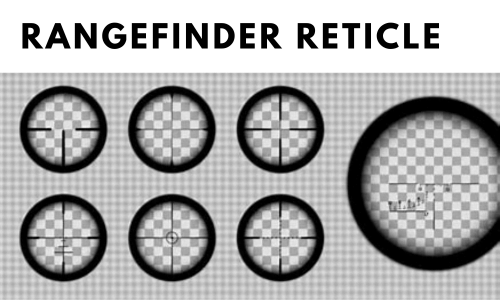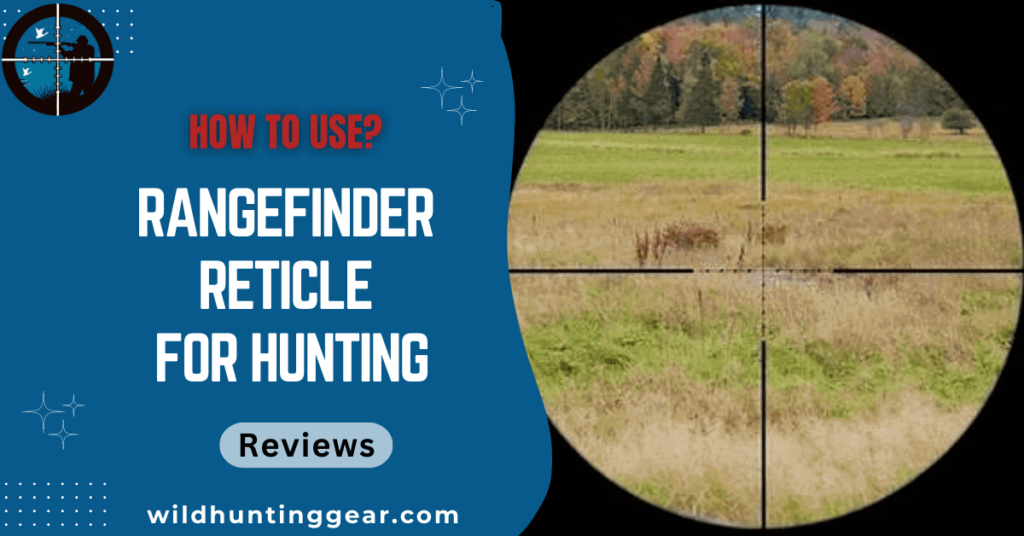When it comes to hunting, precision and accuracy are essential for success. One valuable tool that can greatly enhance your hunting skills is a rangefinder reticle. This innovative device combines the functionality of a rangefinder with a reticle, allowing hunters to measure distances and make precise shots with ease.
In this blog post, we’ll explain how rangefinder reticles work and provide insights on best practices when using them for hunting applications.
Whether you’re an experienced hunter or newbie, this post will teach you all about these extremely helpful tools that can help take your skillset up a notch. So read on for more information.

What is a Rangefinder Reticle?
A Rangefinder Reticle is a type of aiming device used to help calculate the distance between the shooter and the target. It is often found in scopes and sights used in hunting and precision shooting and consists of a Rangefinding scale or grid that can be used to measure the size of a target using the relationship between the size of the reticle and the distance of the target.
The shooter can measure the target size and use the scale to estimate the distance, allowing them to make more precise shots. Rangefinder Reticles come in many different sizes and shapes, including circles, crosses and other geometric patterns. They can also be illuminated for night shooting.
Many modern reticles are equipped with advanced features such as range estimation markers that can display estimated distances to the target for easier aiming at unknown ranges.
Related Article: How to Use a Rangefinder Camera and How it Work
How does it work?
Rangefinder Reticles work by taking basic measurements of the target size and distance. The reticle consists of a series of lines and markers that can be used to estimate the size of the target at different ranges.

A shooter can measure the size of a target by placing it between two points on the reticle, then use the known relationship between the reticle scale and the target size to estimate the distance to the target.
The reticle can be adjusted to match the magnification of your scope, so you only need one set of markings for all magnifications. This makes them especially useful in tactical situations where a rapid estimation of the range is required.
Rangefinder Reticles are often used by hunters, competitive shooters and law enforcement personnel. They are also popular among recreational shooters, as they provide an easy and accurate way to estimate the space between objects.
Rangefinder Reticles can make shooting more enjoyable and add a level of precision that is not always possible with conventional methods. With practice, you can become a much better shooter by understanding how to use these devices effectively.
Step-by-step guide to using a rangefinder reticle for hunting
- Familiarize yourself with the reticle:
Rangefinder reticles come in a variety of shapes and sizes, including horizontal bars, dots, crosshairs and circles. Read about the different designs available and understand how each one works. This will help you pick out the best model for your needs.
- Mount the reticle on your gun:
Most rangefinder reticles come with mounting hardware that should be installed on the side of your gun. Be sure to read the instructions carefully and double-check all connections before use.
- Learn how to adjust the reticle:
Rangefinder reticles have adjustable settings for distance and windage. Take some time to go through the manual and learn how to adjust these settings for maximum accuracy.
- Practice using the reticle:
Once you’re familiar with how the reticle works, it’s time to take it out for a test run. Find an open field or shooting range and practice aiming at targets of different distances. Take notes on your performance so you can make adjustments later if needed.
- Go hunting with the reticle:
When you’re confident in your skills, it’s time to take the rangefinder reticle out into the field. Pay close attention to wind speeds and use the adjustable settings on your reticle to ensure an accurate shot. With practice, you’ll be able to hit your targets quickly and efficiently.
Best practices and tips when using a rangefinder reticle
Using a rangefinder reticle can be an effective way to accurately estimate distances.
Here are some best practices and tips when using this powerful tool:
- Make sure you set up the reticle with the correct parameters for your specific environment, such as the terrain type, atmospheric conditions and illumination.
- When first focusing on an object, use the lower power setting before zooming in to get a more accurate measurement.
- Measure distances often and consistently to ensure accuracy. This is especially important when shooting at long-range targets or in changing conditions such as wind speed or elevation changes.
- Use multiple reference points for validation – objects that are closer or farther away from the target. This will help ensure you are not overestimating or underestimating the distance to the target.
- If possible, use a calibrated reticle that has been professionally set up with standard measurement increments for your environment and specific rangefinder model.
- When ranging targets, look through the scope from a stable position and be sure to keep your head still.
- Practice using the rangefinder reticle frequently to become familiar with its use and ensure accuracy.
Following these best practices and tips will help you get more accurate readings from your rangefinder reticle and make sure you hit your targets with confidence!
Common mistakes to avoid when using a rangefinder reticle
Here are some common mistakes to avoid when using a rangefinder reticle.
| Mistake | Explanation |
| Not Checking Distance First | Do not assume that the reticle will automatically determine the correct range and adjust accordingly. Always check the distance to your target first before adjusting the reticle for a shot. |
| Not Taking Wind Into Account | The wind can affect your aim and the speed of the bullet. When using a rangefinder reticle, factor in wind speeds and adjust your aim accordingly. |
| Not Adjusting Reticle for Parallax | If your target is further away than your typical shooting distance, you should adjust the reticle to account for parallax. This will help ensure that you are aiming accurately at different ranges. |
| Not Knowing Reticle Reference Points | You should familiarize yourself with the reference points of the reticle so that you can quickly adjust for range and wind. If you do not know how to use the reticle, it may not be as effective. |
| Not Adjusting for Light Conditions | Different light conditions can change the reticle’s appearance and make it difficult to read. Make sure to adjust the brightness or contrast of the reticle so that you have a clear view of your target. |
Safety Measures when Using a Rangefinder Reticle.
When using a rangefinder reticle, it is important to take certain safety measures to ensure the accuracy and safety of your shooting.
Here are some of the key points:
- Make sure the rangefinder reticle is correctly calibrated for the distance at which you will be shooting. This will help avoid misfiring or hitting something other than your intended target.
- Make sure the reticle is in focus and the crosshairs are visible before firing a shot. This will help ensure accuracy and reduce the chances of misfires or hitting something other than your intended target.
- Keep your eyes focused on your target at all times when using a rangefinder reticle, as it can be easy to forget where the reticle is.
- Make sure that you’re aware of your surroundings and any potential obstacles or obstructions which could disrupt your line of sight, such as trees, rocks or buildings.
- Ensure that you’re familiar with your firearm and its safety features before using a rangefinder reticle, such as setting the safety on and off and how to unload it in the event of a misfire.
- Make sure that you’re familiar with the rangefinder reticle’s features, such as its magnification and the location of its power switch.
- Never point your firearm at anything you don’t intend to shoot or fire at. When using a rangefinder reticle, it is important to keep the reticle and firearm pointed at the ground or away from people.
Following these safety tips will help you stay safe and use your rangefinder reticle accurately.
Consequence:
A rangefinder reticle is a valuable tool for hunters that can greatly enhance their accuracy and effectiveness in the field. Using a rangefinder reticle simplifies the process of determining the distance to a target and making accurate shots.
Understanding how a rangefinder reticle works is crucial for utilizing it effectively. By aligning the target with the appropriate reticle marks and adjusting for the calculated distance, hunters can make ethical shots with confidence.
However, it is important to remember that using a rangefinder reticle requires practice and familiarity to ensure proficiency in the field. With proper knowledge, skill and practice, hunters can harness the full potential of a rangefinder reticle to improve their hunting experience.




